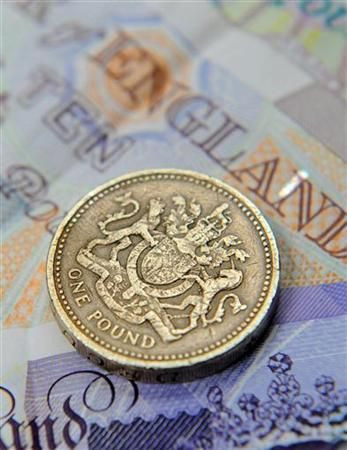UK Sells Long-Term Bonds With Negative Yield For First Time In History As BoE Mulls Below-Zero Rates

KEY POINTS
- The U.K. Treasury sold about $4.66 billion of three-year bonds at a yield of minus-0.003%.
- Germany and Japan have already issued government bonds with a negative yield
- The Bank of England reduced its benchmark interest rate to an all-time low of 0.1% in March
As the Bank of England debates whether or not it should push its key interest rate below zero, the U.K. government has just sold its first long-term bond with a negative yield on Wednesday.
The U.K. Treasury’s Debt Management Office said it sold about $4.66 billion of three-year bonds at a yield of minus-0.003%.
(In 2016, the U.K. Treasury did sell short-term, one or three-month bonds at a negative yield, but this was the first time for longer term bonds)
Essentially, with a negative-yielding bond, investors are paying the British government to borrow. If they hold the bond to maturity, investors will receive slightly less than what they paid out initially.
The Guardian wrote that with a negative-yielding bond investors “have to pay to lend money to fund the government’s response to the Covid-19 pandemic.”
Germany, Japan and some other European nations have already issued government bonds with a negative yield.
The Bank of England is also purchasing hundreds of billions of dollars of government bonds.
“When central banks discuss the rationale for their actions, driving down government borrowing costs is rarely a goal that is emphasized” said Hugh Gimber, global market strategist at J.P. Morgan Asset Management. “But while this may not be made explicit, the impact of the Bank of England’s rate cuts and increased asset purchases is absolutely clear from this morning’s groundbreaking gilt auction.”
Gimber further noted that Bank of England bond purchases will probably continue to “ensure that the government can finance its record levels of borrowing at record low rates over the coming quarters.”
Marc Ostwald, strategist at ADM Investor Services, pointed out that not all negative-yield bond buyers will necessarily lose money on their investment. Some investors hope the bond’s price will increase enough so they can sell it. Other investors may be seeking to hedge against the risk of the Bank of England reducing rates below zero.
Oliver Blackbourn, a portfolio manager at Janus Henderson Investors, said the negative yield bond sale was “more of a symbolic moment” as investors are getting used to negative yields on government bonds across the world.
“Demand for nominal bonds, even at these levels, may persist. This issue is not going away,” he added.
However, demand for Wednesday’s bond was relatively low. In contrast, a new 10-year bond offered last week attracted a record $100 billion in orders.
For British pension funds, which are restricted in what they can invest in, negative yields would surely increase costs and may require employers to provide a cash payout.
“This may be the last thing the sponsor needs, given the current economic situation and the potential difficulty in affording those extra payments,” said pension fund trustee Vassos Vassou of Dalriada Trustees.
Meanwhile, since the Bank of England reduced its benchmark interest rate to an all-time low of 0.1% in March, speculation has grown that the central bank may push the rate into negative territory in order to fight the harmful economic effects of the coronavirus pandemic.
The decline in Britain’s annual inflation rate from 1.5% to 0.8% would add more credence to the premise that the Bank of England may indeed have to push rates below zero.
Former Bank of England Governor Mark Carney opposed the idea of negative interest rates, but with him gone and some policymakers considering it, it could conceivably happen.
The Bank of England’s chief economist, Andy Haldane and Bank of England Governor Andrew Bailey have both stated the central bank may consider negative interest rates.
But most analysts seem to oppose the strategy.
Kit Juckes, a macro strategist at Societe General, thinks negative interest rates would not be beneficial.
“Personally, I can’t think of an economy where negative rates are a worse idea than the U.K.,” he said. “The Chancellor [of the Exchequer Rishi Sunak] has dramatically increased government borrowing and the Bank of England is buying the economy time by mopping most of it up. How on earth does it make sense to even consider adding negative rates to the mix?”
Juckes added: “The economic benefits are dubious but the power of a cocktail of negative rates and massive quantitative easing to weaken the currency seems clear and if the pound falls enough, it will make [quantitative easing] harder.”
John Wraith, head of U.K. rates strategy at UBS, said: “They [Bank of England] have willingly talked about negative rates as a concept and allowed the debate to intensify, but if you say to a policy maker ‘Would you cut interest rates below zero?’, they’re not going to rule anything out. Then people go ‘he was saying negative rates were possible’ and then it becomes more self-fulfilling.”
Andrew Wilson, chairman of global fixed income at Goldman Sachs Asset Management, said: “Negative interest rates are a tool that has limited value and the escape from negative rates is extremely challenging, as the [European Central Bank] is discovering. Our view is that negative rates are not the way out of this.”
© Copyright IBTimes 2025. All rights reserved.





















